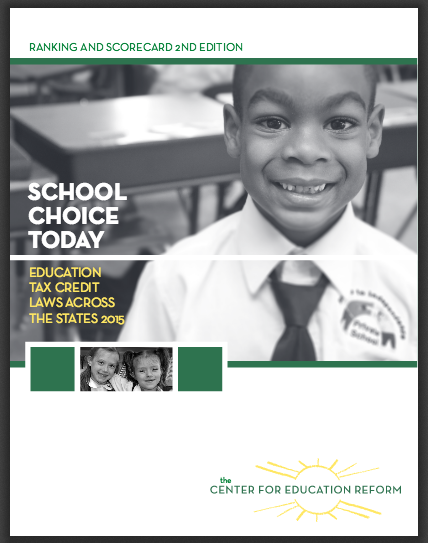by Justin Katz
Watchdog
October 7, 2015
With the release of the Center for Education Reform’s 2015 scorecard for states’ school choice tax credit scholarships, Rhode Islanders with knowledge of the program might wonder how their state managed to squeak out a C grade. The program comes nowhere near satisfying demand–among donors or recipients–and during budget battles, it can seem more like a trading chip legislators throw to a particular constituency.
But with so many states playing tax credit scholarship hooky, Rhode Island is getting credit for trying.
With $931,250 worth of tax credits available for the fiscal year beginning July 1, 2015, 75 businesses applied to give private-school scholarships to disadvantaged children through Rhode Island’s tax credit scholarship program. On July 20, the state Division of Taxation held a lottery, and the applications of just 23 of those businesses were approved.
Last year, $1.7 million in donations through the program funded scholarships for 411 Rhode Island students with low income or developmental challenges to attend 48 schools. That total includes donations carried over from the prior year, as well as those that take advantage of an opportunity for businesses to commit to two years of donations in order to skip the lottery the second year. The 2014 lottery only distributed $643,750 in tax credits to 17 businesses.
Donors aren’t the only ones who would like the program extended; demand for more school choice among parents is high by multiple measures. More than 53-percent of Rhode Island parents would choose private schools for their children “to obtain the best education,” if they could. Yet, only around 12 percent of all students attend such schools, based on research performed for the RI Center for Freedom & Prosperity.
Data provided by the Roman Catholic Diocese of Providence is instructive. The 41 Catholic schools in Rhode Island (not all of them directly run by the diocese) account for the largest portion of the private school sector by far, with around 71 percent of all private-school students.
FACTS Management Company, which handles financing for local Catholic schools, estimates that Rhode Island families need financial aid for 53 percent of the $44 million in total tuition for all Catholic schools in the state, and the diocese is only able to provide about four percent. The rest has to be made up through tuition forgiveness from the schools or money provided by individual parishes or private organizations. As a measurement of demand, these figures don’t include families that might not even bother applying because they believe private school tuition is out of reach.
Yet, fewer than 2 percent of all Catholic school students receive any funds from the scholarship granting organization (SGO) participating in the tax credit program on their behalf. Their average scholarship was $2,348 in 2014, well below the listed tuition at any school and a mere fraction of the $16,075 that the state estimates public schools spent per pupil during the 2013-2014 school year.
As inadequate as the funding may be, however, the tax credit program is closely watched during the legislative session each year. In a state whose economy continues to struggle, a program that helps to add an average of nine children to each of the participating schools can’t be dismissed.
Along with state-level funding for a textbook loan program and a busing program–passed through students’ home public school districts, in both cases–the tax credit funding can take on the appearance of a sop to communities that are deeply involved with private schools, most of which are religious in nature. Conspicuously, the $1 million cap placed on the program when it was created in 2006 wasn’t increased–to $1.5 million–until 2013, the year that the legislature passed same-sex marriage into law over the objections of some of the same religious communities.
Given the limits–and political uses–of Rhode Island’s tax credit scholarship program, locals can be surprised to see their state listed among those that have implemented school choice. Their actual opportunities hardly seem to count.
Of course, according to the Center for Education Reform, only 16 states offer similar tax credits. Of those, Rhode Island ranks eleventh, edging out Virginia, Louisiana, and three states that had yet to provide a single scholarship in time to get credit on the scorecard.
In other words, Rhode Island seems to have earned its C grade mostly by showing up for class.
That result does not serve Rhode Island students or their families well. Raising the program’s cap, perhaps with automatic increases based on demand, loosening restrictions on who can participate as a donor or a recipient, and providing stability so that students don’t have their education on the line with a lottery every year would move the state toward the head of the national class.
A C grade is passing, but Rhode Island students deserve an A in school choice.















Purpose Of Charters And Specialized Schooling
After reading “Measuring Diversity in Charter School Offerings” by Michael Q. McShane and Jenn Hatfield, my understanding of charter schools has been broadened and solidified. Before reading this report, I knew what a charter school was – a school that is run independently, yet is still funded by the state. However, I now understand just why it is so important for them to run independently and why non-traditional schooling is relevant and necessary.
In sum, the report clarifies the types of charter schools and explores the demographics of over 1,000 charter schools across 17 cities. Among these charter schools, there are “specialized schools,” which I believe are the most important. Throughout these cities, there are different types of charter schools, some “specialized” and some more traditional, and this is sometimes a result of the cities’ demographics. For example, McShane and Hatfield explain that in general, there is a higher enrollment in “no-excuse schools” (schools that are very strict with student’s behavior and attendance) when there is a high percentage of black residents in the city. There are many theories about why this is, but I have my own theories as well.
Firstly, I agree with the idea in their report that “academic achievement is often the primary concern for low-income communities,” and for that reason there are many more “no-excuse” schools. However, I also believe that in poorer areas, students have many more burdens than students who live in wealthy areas. Sometimes they may be afraid to leave the house or go to school, and thus, hybrid/online learning may be necessary. Also, international/foreign language schools may help students of immigrant families feel more at home. And lastly, art schools are most important to me. Art schools are the perfect outlet for a student to express their emotions, in a productive way, while learning. Of course students in wealthy areas attend art school as well, but to me, it seems very important for students in low-income areas. All of these specialized schools have specific purposes in any city in America- wealthy or poor.
Lastly, the article explains the two main arguments of the purpose of charter schools. The first is that charter schools can “increase student achievement,” and the second explains that the “freedom given to charter schools will allow for the creation of schools with more diverse offerings than may be created by traditional schools.” Both of these arguments are very valid and true, in my opinion. As I explained earlier, there are specialized schools, and this is what I find to be most important. I believe that by having these specialized schools that have much more freedom than traditional public/private schools, students’ achievements will increase much more, and graduation rates will rise. If a school is a perfect fit for a student (especially poorer students) – whether it is an online school, a foreign language school, an art school, or a single sex school – a student’s confidence level, intelligence level, and achievement level will all rise significantly. These two “arguments” should not be separated; they should work hand in hand with one another.
A school must fit each and every one of these needs, and these specialized charters do that. Once a student is at the school of their liking, which has much more freedom and choice, the achievement levels will increase significantly.
Gianna Manzella, CER Intern